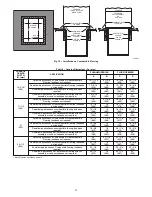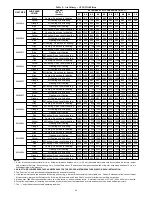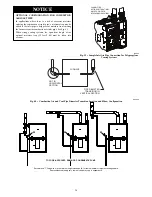
37
Sidewall terminations may require sealing or shielding of building
surfaces with a corrosive resistance material due to the corrosive
properties of combustion products from the vent system, as well as
protection of adjacent structures.
RECOMMENDED SUPPORT FOR
VENT TERMINATIONS
It is recommended that sidewall vent terminations in excess of
24 inches (0.6 M) or rooftop terminations in excess of 36
inches (1 M) in vertical length be supported by
EITHER
the
Direct Vent Termination Kit shown in Table 12 or by
field--supplied brackets or supports fastened to the structure.
NOTICE
When determining appropriate location for termination, consider
the following guidelines:
1. Comply with all clearance requirements stated in Fig. 52 or
Fig. 53 per application.
2. The vent termination must be located at least 3 feet from an
inside corner and follow the clearance distances in the In-
side Corner Termination drawing.
3. Termination or termination kit should be positioned where
vent vapors will not damage plants/shrubs, air conditioning
equipment or utility meters.
4. Do not locate termination directly into prevailing winds.
Termination should be positioned so that it will not be
affected by sustained prevailing winds over 30 mph, wind
eddy, such as inside building corners, or by recirculation of
flue gases, airborne leaves, or light snow.
5. Termination or termination kit should be positioned where it
will not be damaged by or subjected to foreign objects such
as stones, balls, etc.
6. Termination or termination kit should be positioned where
vent vapors are not objectionable
.
Direct Vent / 2-Pipe System
Direct vent (2--pipe) vent and combustion air pipes must terminate
outside the structure. See Fig. 52 For references to vent clearances
required by National code authorities.
Allowable vent and
combustion air terminations are shown in Fig. 54.
CARBON MONOXIDE POISONING HAZARD
Failure to follow the instructions outlined below for each
appliance being placed into operation could result in carbon
monoxide poisoning or death.
For all venting configurations for this appliance and other gas
appliances placed into operation for the structure, provisions
for adequate combustion, ventilation, and dilution air must be
provided in accordance with:
U.S.A. Installations
: Current edition
of Section 9.3 N
FPA
54/ANSI Z223.1 Air for Combustion and Ventilation and
applicable provisions of the local building codes.
Canadian Installations
: Current edition of Part 8 of
CAN/CSA--B149.1. Venting Systems and Air Supply for
Appliances and all authorities having jurisdiction.
!
WARNING
Ventilated Combustion Air
The vent pipe for a Ventilated Combustion Air System must
terminate outdoors. See Fig. 53 for references to vent clearances
required by National code authorities. Allowable vent terminations
are shown in Fig. 55. The combustion air pipe terminates in a
well--ventilated attic or crawl space. Follow the clearances as
shown in Fig. 57.
The combustion air pipe cannot terminate in attics or crawl spaces
that use ventilation fans designed to operate in the heating season.
If ventilation fans are present in these areas, the combustion air
pipe must terminate outdoors as a Direct Vent System.
Non-Direct Vent / 1-Pipe System
The vent pipe for a Non Direct Vent (1--pipe) system must
terminate outdoors. See Fig. 53 for references to vent clearances
required by National Code authorities.
Allowable vent
terminations are shown in Fig. 55.
A combustion air inlet pipe to the outdoors is not required for a
Non--Direct (single--pipe) Vent System. A 12--in. long section of
pipe with a tight radius 2--in. (51 mm) 90 degree elbow is required
to be attached to the furnace. See Fig. 56. This short inlet air pipe
helps to ensure stable combustion, as well as allow for sound
attenuation. To aid sound attenuation, point the inlet air pipe away
from occupants. An extra elbow and/or five feet of pipe may be
used to accomplish the sound attenuation function.
Termination Requirements for the Provinces of Alberta and
Saskatchewan
The Provinces of Alberta and Saskatchewan require a minimum
unobstructed distance of 4 ft. (1.2 M) from the foundation to the
property line of the adjacent lot for vent termination of any
appliance with an input over 35,000 btuh. If there is less than 4 ft.
(1.2 M) of unobstructed distance to the property line of the
adjacent lot, no type of vent termination is permitted for appliances
with inputs greater than 35,000 btuh.
There are no additional restrictions on unobstructed distances
greater than 8 ft. (2.4 M). All single, two-pipe and concentric vents
may be used, providing all other Code and manufacturer’s
requirements in these instructions are adhered to. Refer to the
appropriate
Vent Termination
section above for locating the vent
termination
If the unobstructed distance from the foundation to the property
line of the adjacent lot is no less than 4 ft. (1.2 M) and no greater
than 8 ft. (2.4 M), it will be necessary to re-direct the flue gas
plume. In this situation, a concentric vent kit cannot be used. A
2-pipe termination (or single pipe termination when permitted) that
re-directs the flue gas away by use of an elbow or tee, certified to
ULC S636 from the adjacent property line must be used. See Fig.
56.
The concentric vent kit currently cannot be modified to attach an
elbow to the vent portion of the rain cap. A tee attached to the rain
cap could potentially direct the flue gas plume toward the intake air
stream and contaminate the incoming combustion air for the
furnace.
Refer to Fig. 56 for terminations approved for use in Alberta and
Saskatchewan.
Size the Vent and Combustion Air Pipes
General
Furnace combustion air and vent pipe connections are sized for
2-in. (50 mm ND) PVC/ABS DWV pipe. The combustion air and
vent pipe connections also accommodate 60 mm polypropylene
venting systems with outside diameters of approximately 60 mm
(2--3/8 inches). Any pipe diameter change should be made outside
furnace casing in vertical pipe. Any change in diameter to the pipe
must be made as close to the furnace as reasonably possible. See
Fig. 40.
The Maximum Vent Length for the vent and combustion air pipe
(when used) is determined from the Maximum Equivalent Vent
Length in Table 16 minus the number of fittings multiplied by the
deduction for each type of fitting used from Table 17.
















































